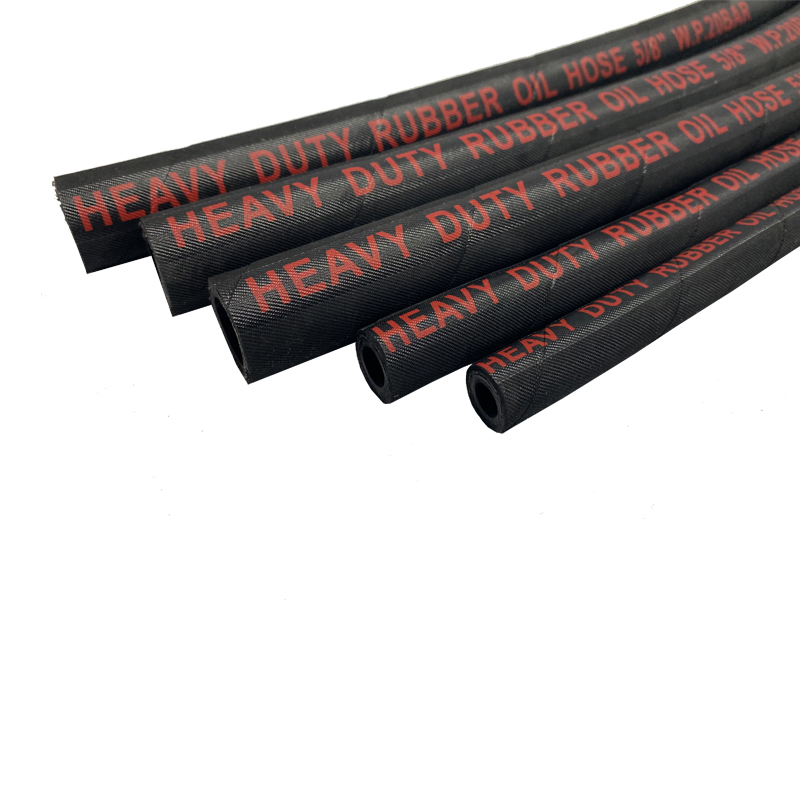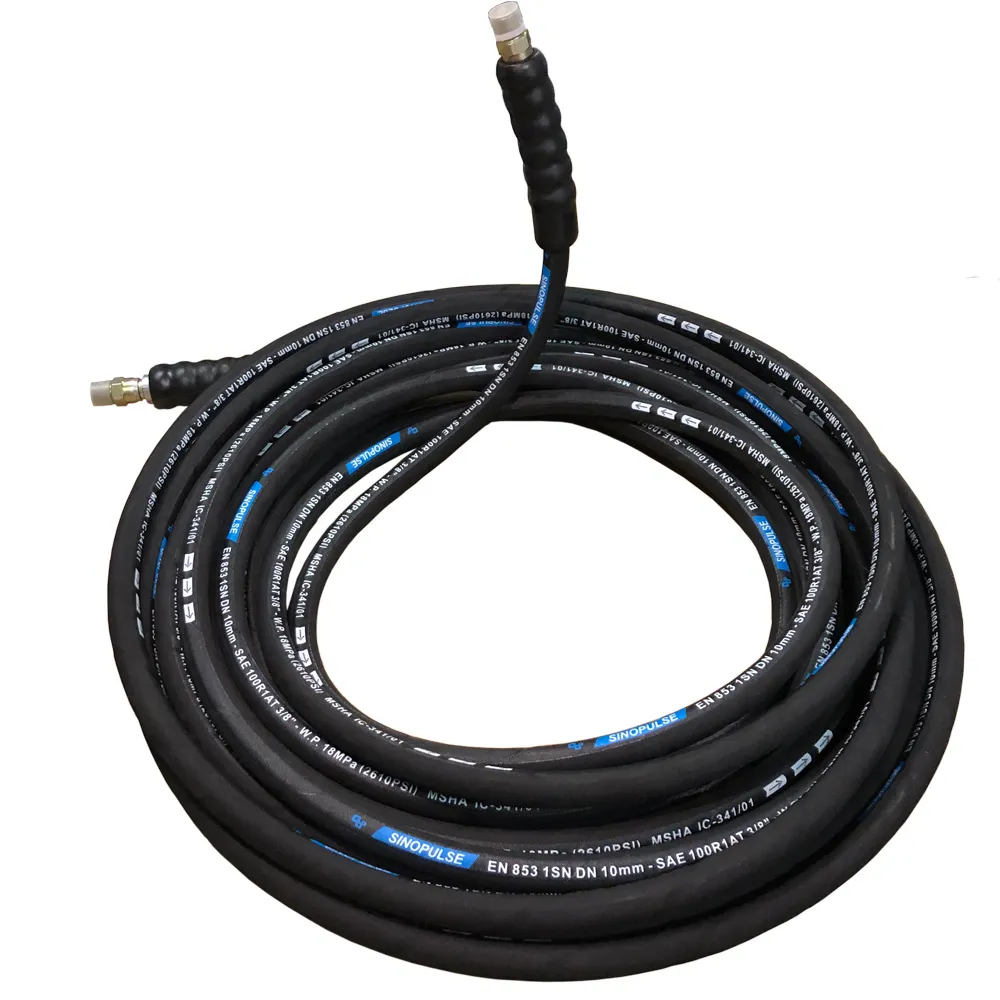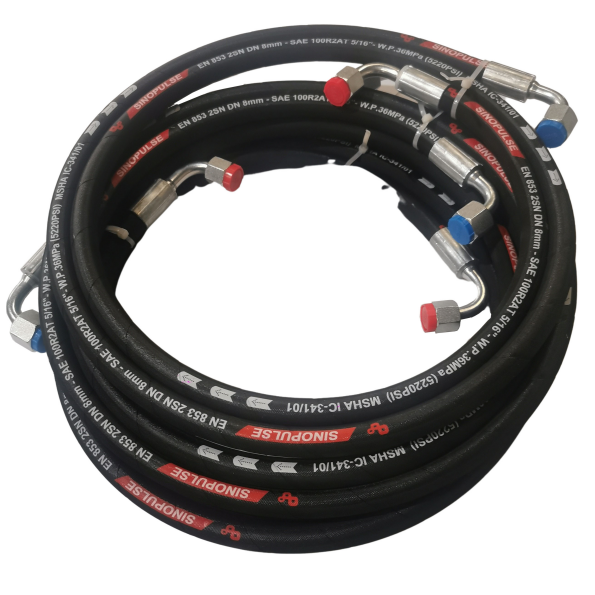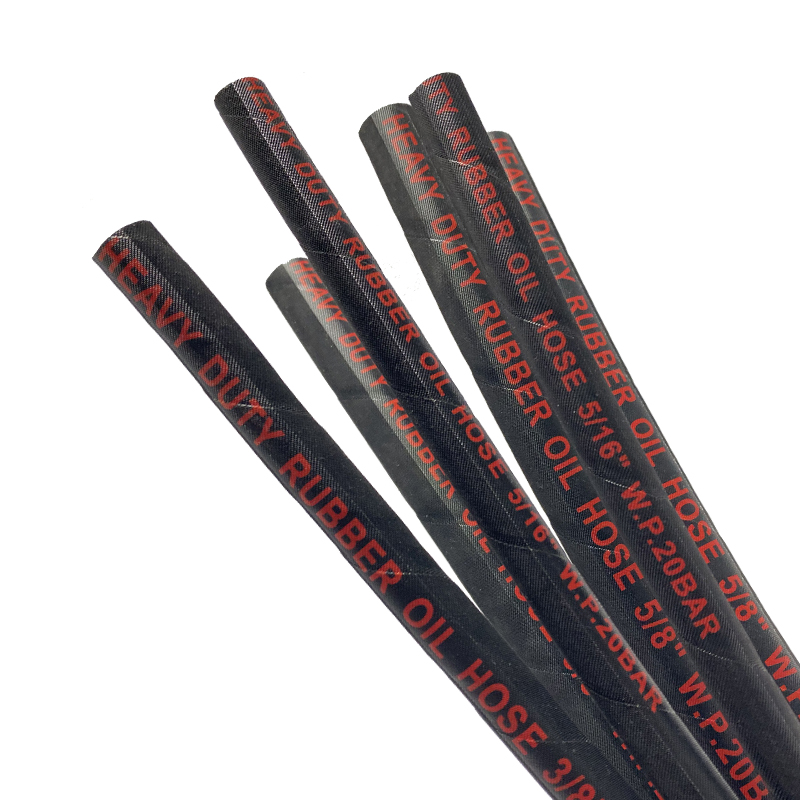Oil Hose
An oil hose is a specialized flexible tube designed to transfer various types of oils, including lubricants, hydraulic fluids, and fuel oils, in industrial, automotive, and agricultural systems.
Constructed with oil-resistant inner tubes, robust reinforcements, and durable outer covers, oil hoses are engineered to handle high pressures and harsh conditions while maintaining flexibility and longevity. These hoses are widely used in applications like hydraulic systems, engine lubrication, fuel delivery, and oil transfer in machinery and equipment. For example, in hydraulic systems, oil hoses ensure a steady flow of hydraulic fluid between components, facilitating smooth operation. In automotive engines, they carry motor oil for lubrication and cooling. Industrial applications involve transferring large volumes of oil from storage tanks to equipment or pipelines. Oil hoses are also essential in agriculture for powering tractors and other oil-dependent machinery. Their reliable construction and compatibility with various oil types make them indispensable for maintaining efficient and safe operations across multiple industries.
What Are the Main Materials Used in Oil Hoses, And How Do They Impact Performance?
Oil hoses, crucial for various oil-related operations, are typically made with materials like nitrile rubber (NBR), synthetic rubber, thermoplastics, and PVC, each chosen for its specific properties to handle oil transfer effectively in different types of oil hoses. For instance, oil cooler hoses often require materials that can handle heat dissipation while transferring oil. Nitrile rubber, known for making excellent oil-resistant hoses, is widely used for its excellent resistance to oil, fuel, and grease, making it ideal for automotive and industrial applications.
Synthetic rubber offers enhanced flexibility and durability, especially in high-pressure environments, while also resisting aging and cracking. This makes it a great choice for oil pressure hoses that need to maintain their integrity under pressure. Thermoplastic materials provide lightweight construction and resistance to abrasion and environmental factors, making them suitable for portable or outdoor applications.
PVC is commonly used for general-purpose oil hoses due to its affordability and versatility but may not perform as well under extreme temperatures or pressures. In cases where an oil hose needs to be used in a less demanding environment, PVC can be a cost-effective option. Reinforcements such as textile braids, steel wire, or spiral layers enhance the oil hose's strength and pressure tolerance, which is essential for oil pressure hoses in particular. The choice of material impacts the hose's flexibility, temperature range, and compatibility with different oil types, ensuring optimal performance and longevity in specific applications for all industrial hoses.
How Do You Maintain an Oil Hose to Ensure Long-Term Reliability and Safety?
Maintaining an oil hose involves regular inspections, proper handling, and adherence to operational guidelines to prevent failures and extend its service life. Inspect the hose periodically for signs of wear, such as cracks, leaks, blisters, or abrasions, particularly around fittings and bends, as these areas are prone to stress. Replace any damaged hoses immediately to avoid system failures or safety hazards. Clean the hose regularly to remove oil residue, dirt, and contaminants that can degrade the material over time. Proper storage is essential; keep the hose in a cool, dry, and well-ventilated area away from direct sunlight, moisture, and harsh chemicals that can weaken the material. Avoid exceeding the hose's specified pressure, temperature, and bend radius limits during use to prevent overloading and premature wear. Ensure fittings are securely attached and periodically check for leaks or loose connections. By following these maintenance practices, you can ensure reliable performance, enhance safety, and prolong the life of your oil hose.
Analysis of Core Materials and Oil-Resistant Mechanisms in Oil Hoses
SINOPULSE designs high-performance oil hoses with a deep understanding of material science and fluid dynamics. The selection and engineering of core materials play a pivotal role in ensuring hoses can withstand continuous exposure to various oils without degradation. Here’s an in-depth look at the key components and their oil-resistant mechanisms that make SINOPULSE hoses the preferred choice for oil suction, transfer, and delivery applications.
Nitrile Butadiene Rubber (NBR): The Backbone of Oil Resistance
At the heart of SINOPULSE oil-resistant hoses lies Nitrile Butadiene Rubber (NBR), a synthetic elastomer renowned for its exceptional oil compatibility. NBR’s molecular structure, characterized by acrylonitrile monomers, creates a cross-linked network that repels hydrocarbon-based oils. This unique composition minimizes oil absorption, ensuring the hose maintains its physical properties—such as flexibility, strength, and sealing integrity—even after prolonged immersion. For example, in diesel fuel or hydraulic oil applications, NBR-lined hoses exhibit a swelling rate of ≤5%, far surpassing the performance of standard rubber materials.
Reinforcement Layers: Enhancing Structural Integrity
To complement the oil-resistant inner tube, SINOPULSE integrates robust reinforcement layers. High-tensile steel wire braids or synthetic fiber meshes are woven around the NBR core, providing mechanical strength and pressure resistance. These layers distribute internal pressure evenly, enabling oil transfer hoses to handle working pressures up to 40 bar (580 PSI) and burst pressures exceeding 120 bar (1740 PSI). In heavy-duty scenarios like oil tank truck loading or industrial hydraulic systems, the reinforcement prevents tube collapse and leakage, ensuring safe and efficient oil delivery.
Outer Cover: Protection Against External Threats
The outer cover of SINOPULSE oil hoses is engineered to withstand harsh environments while safeguarding the inner components. Made from abrasion-resistant synthetic rubber or thermoplastic compounds, it resists cuts, punctures, and UV degradation—common hazards in outdoor oil transfer operations. Additionally, anti-static outer layers are available for applications involving flammable oils, dissipating electrical charges to prevent ignition risks.
Advanced Formulations for Specialized Oils
For applications requiring compatibility with synthetic lubricants, biofuels, or high-viscosity oils, SINOPULSE offers oil hoses with advanced material formulations. Fluoroelastomer (FKM) liners, for instance, provide superior resistance to aggressive chemicals and high temperatures, making them ideal for aerospace or automotive manufacturing. These specialized hoses undergo rigorous testing to ensure compliance with industry standards, such as ISO 18752 for fuel hose performance.
In industries where reliable oil transfer is non-negotiable, SINOPULSE’s commitment to material innovation and engineering excellence ensures that our oil hoses deliver long-lasting performance, safety, and efficiency.
Fault Warning and Emergency Handling of Oil Hoses
As a trusted oil hose manufacturer, SINOPULSE prioritizes safety and reliability in every oil hose we produce. However, even the most durable oil resistant hoses may encounter issues over time. Understanding how to detect early signs of failure and execute proper emergency protocols is crucial for preventing costly downtime and potential hazards in oil suction, transfer, and delivery operations.
Early Warning Signs of Hose Failure
SINOPULSE recommends regular visual inspections to identify impending issues. Bulges or Swelling indicate internal pressure damage or material degradation, often caused by excessive stress or incompatible oil types. Cracks or cuts in the outer cover expose the inner layers to environmental threats, increasing the risk of leakage. Discoloration or Hardening of the hose material signals chemical breakdown, particularly if the hose has been exposed to incompatible fluids. Additionally, unusual vibrations or whistling noises during operation may suggest blockages or pressure imbalances within the oil hose.
Emergency Response Protocols
In the event of a suspected hose failure, immediate action is essential. First, isolate the system: shut off the oil supply valves and depressurize the line to prevent further leakage. If the hose is used for flammable oils, evacuate the area and prohibit any ignition sources. For minor leaks, applying a specialized hose repair tape designed for oil-resistant materials can provide temporary containment, but this is only a stopgap measure. For significant damage, replace the hose with a SINOPULSE oil transfer hose of the same specification, ensuring proper fitting and alignment to avoid future issues.
Preventive Maintenance for Longevity
To minimize the risk of emergencies, follow SINOPULSE’s maintenance guidelines. Avoid exceeding the hose’s rated working pressure and temperature range, as overloading accelerates wear. When installing oil suction hoses, ensure the bend radius meets specifications to prevent kinking. Regularly clean and lubricate connectors to maintain a tight seal, and store hoses in a cool, dry environment away from direct sunlight to slow down material aging.
With SINOPULSE’s comprehensive approach to oil hose safety, operators can confidently manage potential risks and ensure continuous, secure oil transfer in any industrial setting.












